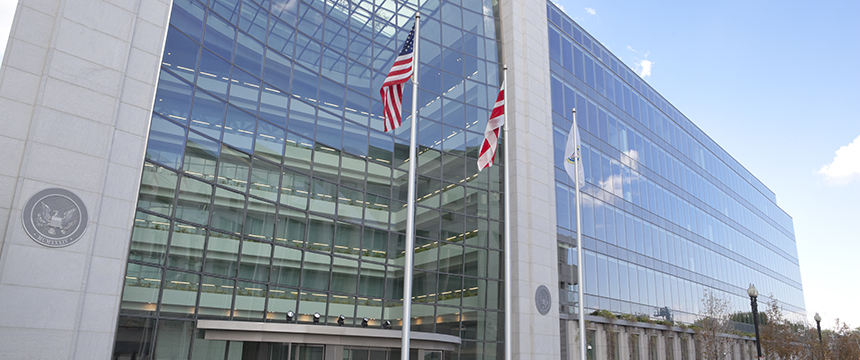
2022年12月14日、米国証券取引委員会(以下「SEC」)は、以下の最終規則を採択した:(1) 規則10b5-1取引計画に適用される新たな条件の追加、(2) 取締役及びセクション16対象役員によるインサイダー取引方針・手続、並びに規則10b5-1取引計画の採用・変更・終了の開示義務化、 (3) 発行者が重要な非公開情報を開示する時期に近い時期に指名された執行役員に対して行われる株式報酬に関する開示要件を改正する、および(4) フォーム4およびフォーム5を改正し、報告義務者に規則10b5-1取引計画に基づく取引を特定すること、ならびにフォーム4においてすべての株式証券の贈与を開示することを義務付ける。
最終規則の効力発生時期
一般; 経過措置規則10b5-1取引計画
最終規則は、連邦官報への掲載日から60日後に発効する。当該日以降、新規または修正された規則10b5-1取引計画は、最終規則の要件に準拠しなければならない。
ただし、最終規則は、最終規則の発効日より前に締結された既存の規則10b5-1取引計画には適用されない。発効日より前に締結された計画であっても、発効日後に計画に基づく取引の金額、価格または時期を変更する修正が行われた場合は、新たな計画の採用とみなされ、最終規則に準拠する必要がある。
SEC提出書類の段階的導入期間:
- 第16条の対象者は 、2023年4月1日以降に提出される報告書から、様式4及び様式5の改正事項を遵守しなければならない。
- 小規模報告会社発行体は、以下に説明する開示要件を、10-Q、10-K、20-Fの定期報告書、および2023年10月1日以降に開始する最初の完全な会計年度をカバーする最初の提出書類から始まるあらゆる委任状または情報説明書において遵守しなければならない。2023年10月1日以降に開始する最初の完全な会計年度( 例:12月31日決算の企業の場合、2023年度Form 10-K)をカバーする最初の 提出書類から、Form 10-Q、10-K、20-Fによる定期報告書および委任状説明書または情報説明書において、以下の開示要件を遵守する必要があります。
- その他のすべての発行体は 、2023年4月1日以降に開始する最初の完全な会計年度(例:12月31日決算の企業の場合、第2四半期Form 10-Q)をカバーする最初の提出書類から、Form 10-Q、10-K、20-Fによる定期報告書および委任状または情報説明書において、下記の開示要件を遵守しなければならない。
背景
2000年以降、規則10b5-1は、当該者が重要な非公開情報を認識していなかった時点で証券取引に関する契約、指示または計画を採用した場合、第10条(b)項のインサイダー取引責任に対する積極的抗弁を確立している。SECは、インサイダー取引および企業内部者による重要な非公開情報の悪用が、市場の健全性を損なうことで個人投資家に損害を与え、市場を傷つけることを認識している。 2000年の制定以来、裁判所、議会、市場参加者は、現行の規則10b5-1では、企業内部関係者が重要な非公開情報に基づいて機会主義的に証券取引を行うことを防止するには不十分であるとの懸念を表明してきた。例えば、企業内部関係者が複数の重複する計画を策定し、その後、最も有利な結果をもたらす計画のみに基づいて選択的に取引を許可することを認めている点が問題視されている。 さらに最近では、これらの最終規則が採択される前に、SECのゲイリー・ゲンスラー委員長も特定の公的声明で懸念を表明している。
こうした活動を踏まえ、SECは投資家の信頼向上と、最終的には流動性及び資本形成の強化を目的とした以下の改正案及び規則を採択した。具体的には、(1)企業内部者が重要非公開情報に基づく取引を実質的に行う手段として規則10b5-1を悪用する機会を減らすこと、及び (2) 規則10b5-1に基づく取引計画、発行体のインサイダー取引に関する方針・手続、および重要非公開情報の開示時期に近い時期に付与される株式報酬に関する発行体の方針・慣行に関する透明性を高めること。
規則10b5-1の改正
最終規則は、規則10b5-1(「10b5-1計画」)の条件を満たすことを意図した契約、指示または計画に基づくインサイダー取引に対する抗弁事由に、以下の新たな条件を追加する:
- クーリングオフ期間:取締役及び役員(規則16a-1(f)に定義されるもの)(「セクション16役員」)は、新たな(または修正された)10b5-1計画に基づく取引を開始するにあたり、以下のいずれか遅い時期まで待機しなければならない:(1) 計画の採択後90日経過後、または(2)計画が採択された会計四半期に関連する発行者の財務結果がForm 10-QまたはForm 10-K(外国私募発行者の場合はForm 6-KまたはForm 20-F)で開示された翌営業日から2営業日後、のいずれか遅い方の日まで待機しなければならない。ただし、計画採択後120日を上限とする。 取締役、セクション16役員、発行体以外の者については、10b5-1計画の採用後30日間がクーリングオフ期間となる。SECは現時点で発行体に対するクーリングオフ期間の採用を見送ったが、発行体による10b5-1計画の悪用(自社株買いの文脈など)を抑制するために規制措置が必要かどうか検討中であることを付記した。 最終規則ではさらに、10b5-1計画の基礎となる証券の売買額・価格・時期の変更(書面による計算式・アルゴリズム、またはこれらに影響するコンピュータプログラムの変更を含む)は当該計画の終了および新規計画の採用とみなされ、新たなクーリングオフ期間が開始される旨を規定している。
- 取締役及び役員の証明書: 取締役および第16条の役員は、10b5-1計画の採用または変更時に以下の事項を証明する表明を当該計画に含めなければならない:(1) 発行者またはその証券に関する重要な非公開情報を認識していないこと、および(2) 10b5-1計画を誠実に採用しており、規則10b-5の禁止事項を回避する目的で採用していないこと。 SECの提案規則とは異なり、最終規則では、この表明を発行者に提出する別個の文書に記載することや10年間保存することを要求していない。この表明は、内部者取引に関する第10条(b)および規則10b-5に基づく独立した責任根拠を生じさせない。
- 重複する10b5-1計画の禁止発行者以外の者は、同時に複数の10b5-1計画を有効にすることはできない。ただし、最終規則では、重複する10b5-1計画の禁止に対する以下の例外を定めている:
- 複数のブローカーとの統合契約:異なるブローカーディーラーまたはその他の代理人との個別の契約は、各契約が全体として適用条件を満たし、かつ規則10b5-1の規定に集合的に従う場合、単一の10b5-1計画として扱われることがある。この例外に基づき、いずれかの契約の変更は他のすべての契約の変更を構成する。 証券の売買数量、価格、時期に関する10b5-1計画の条件が変更されない限り、ブローカー・ディーラーまたは代理人の交代は変更とはみなされない。
- 後発プラン:個人は、後発プランに基づく取引が、先行プランに基づく全ての取引が完了するか、未執行のまま期限切れとなるまで開始が許可されないこと、かつ当該プランが規則10b5-1のその他の条件を全て満たすことを条件に、同時に二つの別個の10b5-1プランを維持することができる。 ただし、先に開始した計画が満了日前に終了した場合、後から開始する計画のクーリングオフ期間は、先に開始した計画の終了日をもって開始したものとみなされる。
- 「売却による税額充当」プラン:制限付株式や株式評価権などの株式報酬が権利確定した時点で、当該個人が税額源泉徴収義務を履行するため、かつ当該個人が売却時期を別途管理できない場合に限り、適格な「売却による税額充当」取引のみを認める追加プランを締結することが可能である。SECは、この例外がオプション報酬の行使に伴う売却には適用されないことを明記した。
- 単一取引計画の制限:発行者を除くすべての者は、12か月間の期間において単一取引計画について規則10b5-1の積極的抗弁を一度のみ主張できる。最終規則では、重複計画の禁止と併せて前述の「売付による決済」計画についてはこの制限の例外を定めている。 「単一取引計画」とは、証券の売買を単一取引として「実行するよう設計された」10b5-1計画を指し、計画が実質的にそのような結果を要求する場合を含む。SECは、以下の場合には10b5-1計画が「単一取引計画」に該当しないと指摘している:(1) 計画が代理人に単一取引として実行するか否かの裁量権を委ねている場合、または (2) 代理人に裁量権を委ねず、代わりに計画策定時点で未知の事象やデータ(例:複数の特定将来株価における一定数量の売買を規定する計画)に依存して代理人の将来の行為を決定し、かつ計画策定時点で複数取引が生じる可能性が合理的に予見される場合。
- 善意の要件:10b5-1計画に参加した者は、当該計画に関して「善意をもって行動した」ものとみなされる。この要件は、10b5-1計画が採用された時点から計画の存続期間を通じて、当該者が善意をもって行動しなければならないことを意味する。
規則10b5-1の改正は、発行者、取締役、セクション16役員、その他の者による計画の採用、変更、または終了の有無に応じて、異なる者に対して異なる取扱いと適用性を定めている。以下のマトリックスは、各種類の者に適用される改正内容を示す:
|
|
発行者 |
取締役および |
発行者、取締役または第16条の役員以外の者 |
|
90日間のクーリングオフ期間* |
|
X |
|
|
30日間のクーリングオフ期間 |
|
|
X |
|
認証 |
|
X |
|
|
重複計画禁止 |
|
X |
X |
|
単一取引プラン制限 |
|
X |
X |
|
善意の条件 |
X |
X |
X |
取締役およびセクション16対象役員は、新たな(または修正された)10b5-1計画に基づく取引を開始するにあたり、以下のいずれか遅い時期まで待機しなければならない:(1) 計画の採択後90日経過後、または(2)計画が採択された会計四半期に関連する発行体の財務結果がForm 10-QまたはForm 10-K(外国私募発行体の場合はForm 6-KまたはForm 20-F)で開示された翌営業日から2営業日後、のいずれか遅い方の日まで待たなければならない。ただし、計画採択後120日を上限とする冷却期間が適用される。
追加関連開示事項
最終規則は、上記の適用される段階的導入期間の対象となる発行体に対し、以下の新たな開示要件を追加する。
取引手配に関する四半期報告
発行体は、Form 10-QおよびForm 10-Kにおいて以下の事項を開示しなければならない。 (1) 発行体の直近四半期において、取締役またはセクション16対象役員が10b5-1計画または非規則10b5-1取引取決めを採用または終了したか否か、(2) 10b5-1計画または非規則10b5-1取引取決めの重要な条件の説明を提供すること。 発行体は、当該計画または取決めが認める取引価格を開示する必要はないが、取締役またはセクション16役員の氏名・役職、計画の採用または終了日、計画の期間、計画に基づき売却または購入される有価証券の総数などのその他の重要な条件は、開示が義務付けられる。 発行体の直近会計期間中に取締役またはセクション16担当役員が10b5-1計画を変更した場合、既存計画の終了および新規計画の採用とみなされ、開示が必要となる。 「非10b5-1規則取引取決め」とは、最終規則発効前に10b5-1規則に適合していたものの、最終規則で追加された新たな条件には適合しない取引取決めをいう。最終規則は、発行体による10b5-1計画または非10b5-1規則取引取決めの採用・終了の開示を要求しない。
インサイダー取引方針の年次開示
発行体は、取締役、役員、従業員、または発行体自身が発行体の証券を売買またはその他の方法で処分する際の内部者取引に関する方針及び手続を採用しているかどうかを、フォーム10-K及び委任状説明書・情報開示書において開示するか、または採用していない理由を説明しなければならない。 外国私募発行体も、Form 20-Fにおいて同様の開示を行うことが求められる。最終規則では、Form 10-K、Form 20-F、または委任状および情報説明書の本文中での発行体の方針開示は義務付けられていないが、発行体はインサイダー取引方針の写しをForm 10-KまたはForm 20-Fの添付書類として提出することが求められる。 既に倫理規定にインサイダー取引方針を盛り込み、当該倫理規定をForm 10-KまたはForm 20-Fの添付書類として提出している発行体は、当該添付書類へのハイパーリンクを記載するだけで本開示要件を満たすことができる。
ストックオプション付与に関する開示
発行体は、Form 10-Kおよび委任状・情報開示書における役員報酬に関する説明において、ストックオプション、ストック・アプレシエーション・ライツおよび/または類似のオプション類似の金融商品に関する報酬の付与時期に関する方針および慣行を、重要な非公開情報の開示時期と比較した報酬付与時期との関係において記載することが求められる。 これらの開示には、取締役会が報酬付与時期を決定する方法(例:報酬が予め定められたスケジュールに基づいて付与されるか否か)、報酬付与時期を決定する際に取締役会が重要な非公開情報をどのように考慮するか、および発行体が役員報酬の価値に影響を与えるために重要な非公開情報の開示時期を調整したか否かを含める必要がある。
発行者は、前事業年度中にストックオプション、 重要な非公開情報を開示する定期報告書またはForm 8-Kの提出もしくは提供の4営業日前から、当該報告書の提出もしくは提供の翌営業日までという期間内に、指名された執行役員に対してストックオプション、ストック・アプレシエーション・ライツ(SAR)、および/または類似のオプション類似の金融商品(以下「ストック・オプション等」という)を付与した場合:
|
(a) 名称 |
(b) 付与日 |
(c) 付与対象となる原証券の数 |
(d) 付与の行使価格($/株) |
(e) 付与日における当該報酬の公正価値 |
(f) 重要非公開情報の開示直前に終了した取引日と、重要非公開情報の開示直後に開始した取引日との間の、当該報酬の対象となる有価証券の終値の変動率 |
|
PEO |
|
|
|
|
|
|
PFO |
|
|
|
|
|
|
A |
|
|
|
|
|
|
B |
|
|
|
|
|
|
C |
|
|
|
|
|
項目5.02(e)に基づく重要な新規オプション付与のみを報告するフォーム8-Kは、新たな表形式開示を必要としない。 小規模報告会社および新興成長企業は、段階的開示の対象となり、上記表における開示を、最高経営責任者(PEO)、前事業年度末時点で役員を務めていたPEO以外の最高報酬役員2名、および前事業年度末時点で役員を務めていなかったため最高報酬者とならなかったが、その事実がなければ最高報酬者となっていた最大2名の追加個人に限定することが認められる。
インラインXBRLタグ付け
上記の新規開示事項は、インラインXBRLでタグ付けが義務付けられます。
様式4および様式5の変更
2023年4月1日以降、様式4および様式5には、報告された取引が規則10b5-1(c)の「積極的抗弁条件を満たすことを意図した」計画に基づくものであるかどうかを示すための「チェックボックス」要件が追加されます。
さらに、2023年4月1日以降、第16条報告義務者は、株式証券の真正な贈与について、取引実行日から起算して2営業日以内に、様式5ではなく様式4で報告することが義務付けられます。 規則10b5-1の積極的抗弁は有価証券の真正な贈与に対して適用可能であるが、SECは、贈与時に贈与者が重要な非公開情報を認識しており、かつ受贈者が発行者の当該情報開示前に当該有価証券を売却することを知っていたか、または知らなかったことについて過失があった場合には、株式証券の贈与は第10条(b)に基づくインサイダー取引責任の対象となり得ると指摘している。
推奨されるアクション
米証券取引委員会(SEC)のゲイリー・ゲンスラー委員長は、インサイダー取引と規則10b5-1の監視を引き続き優先課題とする見込みだ。わずか2カ月前、SECは企業の最高経営責任者(CEO)と最高技術責任者(CTO)をインサイダー取引で告発した。両者は取引が規則10b5-1に基づく計画に準拠していたと主張していたにもかかわらずである。 最終規則およびSECの現行執行方針を踏まえ、発行体ならびにその取締役・役員は以下の推奨措置を検討すべきである:
- 発行者は、最終規則の新規要件に準拠するため、インサイダー取引ポリシーを必要に応じて見直し・更新するとともに、当該ポリシーが適切に公開開示されるよう整備すべきである。 当該方針には、(1) 取締役、役員およびその他の者(発行体を除く)が適用されるクーリングオフ期間を遵守すること、ならびに (2) 取締役および役員が、10b5-1 プランの採用、変更または終了について発行体に積極的に通知し、かつ当該プランの写しを提供することを義務付ける要件を含めるべきである。発行体は、取締役および役員に対し、発行体への通知義務を喚起し、当該計画が締結されているかどうかを確認するため、D&O質問票を更新することも選択できる。
- 発行体は、最終規則およびこれらの規則に対応するための発行体の新規または改訂された方針について、取締役および役員に対する研修の実施を検討すべきである。
- 取締役および役員は、10b5-1計画に対する新たな条件を踏まえ、同計画のメリットを再考し、代わりに公開取引期間中に取引を実行することを選択する可能性がある。
- 既存の10b5-1計画は、最終規則の結果として修正を要しない(最終規則の発効日後に変更された場合を除く)。ただし、取締役、役員及びその他の者(発行体を除く)は、(1)既存の10b5-1取引計画を再検討し、 (2) 必要に応じて計画の修正、終了、または統合を検討し、(3) 取締役、役員、その他の関係者が10b5-1計画の間に空白期間を設けたくない場合、適切な「冷却期間」を確保するための将来の取引計画の採用スケジュールを作成すべきである。
- 取締役および役員は、ブローカー・ディーラーが通常作成するフォーム10b5-1計画文書を精査し、最終規則で要求される新たな表明が含まれていることを確認する必要がある。
- 発行会社は、取締役会および委員会のスケジュールを再検討し更新し、重要な非公開情報の計画的な開示時期と重ならないよう、会議や内部関係者への報酬付与が行われないようにすべきである。また、内部関係者への報酬付与のタイミングに関する方針を再検討し、更新または策定すべきである。
- 取締役、役員その他の者は、重要な非公開情報を認識している場合に発行体証券を贈与する際には注意を払うべきである。発行体は、インサイダー取引防止方針が贈与にどのように適用されるかを見直すべきである。


